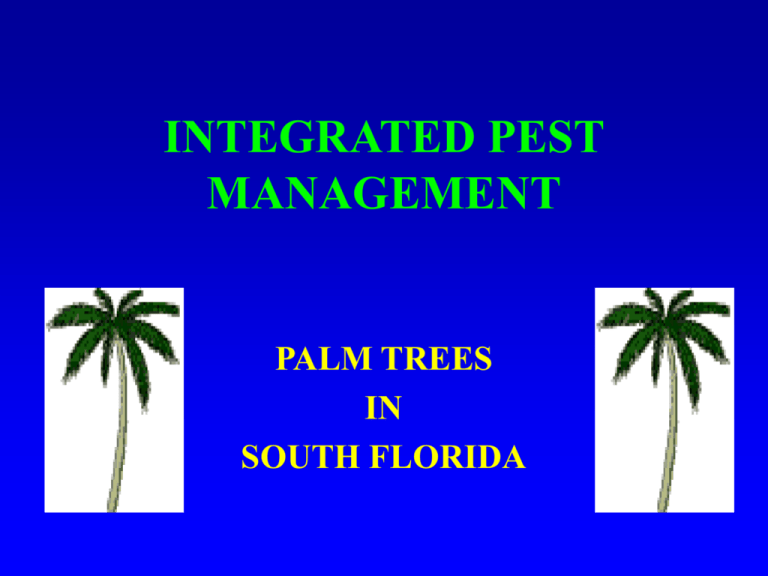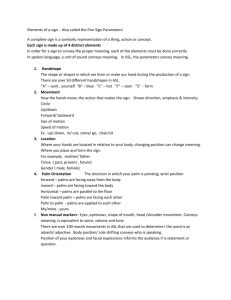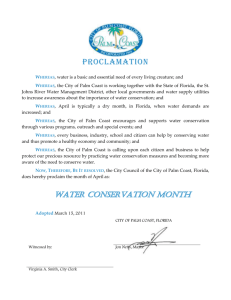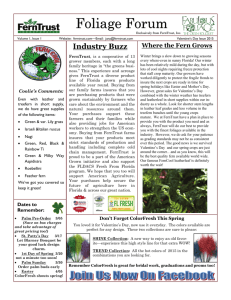integrated pest management - IPM Florida
advertisement

INTEGRATED PEST MANAGEMENT PALM TREES IN SOUTH FLORIDA PALMETTO WEEVILS • Drawn to stressed palms in sub-tropical deep south (mostly cabbage & Canary Island Date palms). • Some species spread nematode in Central and South America and Caribbean. Palm weevils Symptoms & Treatment • Adult females lay eggs in leaf bases of crown, larvae tunnel into heart, destroying the palm. • Crowns of affected palms topple over or “deadhead”. • Reduce transplant stress • Preventative spray of Lindane or Dursban applied at and a few weeks after transplant. Reducing Transplant Stress • Transplant early spring or summer - soil below 65C discourages new root growth. • Remove 1/2 or more of leaves at time of digging to reduce water loss from transpiration. • Optimal drainage. • Avoid transplanting deeper than originally grown. • Micronutrient foliar spray since root absorption is limited. ROYAL PALM BUG • Troublesome pest in Florida and Caribbean. • Infestations increase in Spring and Summer after a mild winter. • Feeds on young leaves getting in between folds of emerging leaf. Treatment • Three species of spiders have been found to prey on royal palm bugs, and suggested that they, along with heavy rains, are major factors in the natural control of the species. • whether populations of these prolific bugs are regulated by spiders and rain alone is still open to question. Tactic not in use. Treatment • A relatively new insecticide discovered by Bayer, imidacloprid, shows promise. It can be applied without a special use permit. • low mammalian toxicity - oral LD50 rates as 1858-2591 mg/kg and the dermal LD50 rate as >2000. • Long term effectiveness due to stability in soil, but may take weeks for root drench to take effect. PALM APHID • Female becomes sedentary like a scale forming a distinctive waxy ring around it. • Heavily infest young leaves and secrete honeydew upon which sooty mold will grow. Sooty Mold • Fungus that feeds upon “honeydew” from aphid, scale, mealybugs. • Interferes with photosynthesis. • Control honeydew producing insects. Leaf Spots • Helminthosporium, Anthracnose, Stigmina, Pestalotiopsis • All cause spots, some merge and form blighted areas. • Easily spread by use of overhead irrigation. False Smut • Significant problem of landscape palms during heavy rainfall. • Grayish-black fruiting bodies on both sides of leaf. • Copper based fungicides and maneb or mancozeb effective if applied in early stages. Phytophthora root rot • Also causes leaf spots and bud rots. • Drenching soil with metylaxyl reduce populations of this fungus. • Foliar applied fosetyl aluminum will translocate to roots of palm. • Prevent overwatering. Ganoderma Butt Rot • Serious and incurable disease of older palms. • Progresses from older leaves upward which turn brown and droop from the trunk. • Wounds on lower trunk allow entry of fungus. Ganoderma butt rot • Fruiting body a conspicuous bracket or conch. • Rapid spread and persistent in soil. • Remove and destroy effected palms and conchs. • Fumigate soil and replant broad-leafed trees (not susceptible). Fusarium wilt • Frequent in California and starting in Florida. • Uneven decline in canopy. • Transferred from tree to tree by pruning tools, so they should be sterilized between uses. Coconut Lethal Yellowing • Incurable disease caused by a mycoplasma-like organism. • Vector - Leaf hopper. • Yellowing and dying of leaves. • Avoid by planting resistant varieties. • Decline temporarily suspended by antibiotic injections. Spider Mites • Biggest problem in greenhouse production. • Chemical controls diminishing. • Best controlled by predatory mites: Phytoseiulus persimilus Neoseiulus californicus Spider Mites • persimilus is a quickacting parasite and is usually released ititially. • californicus is slower moving “bat clean up” and released later. • These tactics work better in greenhouse where plants are tip to tip. Pest Management Approaches • City of Hollywood, Florida, Alice Cohen greenhouse palm production. • Central Florida extension agent for University of Florida, Liz Felter • South Florida extension agent for University of Florida, Bill Schaal greenhouse and field grown palms. City of Hollywood • Palms in landscape, medians, parks, etc. • Palm weevil occasionally a problem - only treat when they see damage. Must spray in crown. • Safe soaps and oils. • Resistant varieties (lethal yellowing) • Stopped planting impatients around trees because water req. is high - promotes fungal pathogens. • Unfortunately, plants are selected by non-horticulturalists for aesthetic value. Some are tropical, req. lot of water which promotes disease. • No biological control used. Central Florida Greenhouse Production • Predatory mites for spider mites. #1 pest. • Scale, #2 pest - no biocontrol. Use Dimethoate or Marathon (systemic). Residue up to 60d, so cannot release biocontrols during this time. • Scouting and record keeping of juvenile sitings. Use calendar documentation in dz. forecasting. • Companies such as Glades Crop Care provide a scouting service, but charge about 600/mo. not seen as cost-effective by most. • Most scouting companies specialize in agronomic crops, not ornamentals. • IPM consultants rare. • Florikan, supplier of growing supplies, focus on IPM products. Pheremone attractants, Opogona (catarpillers for nematode control), pred. mites, etc. Credits • Pictures and info. on : Palm aphid, scale, royal palm bug, palmetto weevils, leaf spots, sooty mold, phytophthera root rot, Fusarium wilt, Ganoderma butt rot, lethal yellowing - Betrodk’s guide to landscape PALMS, Alan Meerow. • Pictures and info on palm weevil/nematode life cycle and spider mites - Palm Production and Culture Resources t the Ft. Lauderdale REC (UFL/IFAS) web site: http://www.ftld.ufl.edu/palm.htm Credits cont’d • Alice Cohen, City of Hollywood, Florida. • Liz Felter, Central Florida Extension Agent. University of Florida, IFAS. • Bill Schaal, South Florida Extension Agent. University of Florida, IFAS.





